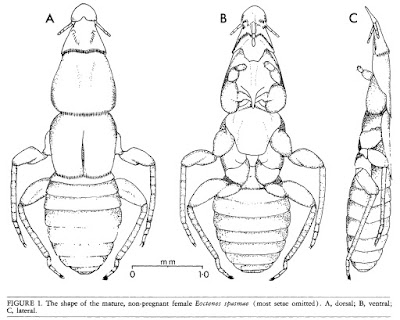The close of the Permian period saw the largest mass extinction ever recorded. It has been estimated that about 95% of all marine species were wiped out. Many prominent Palaeozoic lineages disappeared entirely; others were reduced to a mere remnant of their former selves.
One of the casualties of the end-Permian extinction was the crinoid group known as the Erisocrinoidea (or Erisocrinacea in older texts). These were a diverse group of crinoids divided between several families, recorded from the Carboniferous and Permian periods. One species, Erisocrinus typus, is known from a large number of well-preserved, articulated specimens from the mid-Late Carboniferous of the United States and is one of the best representatives of the Palaeozoic cladid crinoids. Erisocrinoids are characterised by a low cup, dominated by the ring of radial plates. The base of cup was often recessed, meaning that the basal and infrabasal plate rings were often partially or entirely obscured in outer view. Most significantly, the array of anal plates found in other crinoids was reduced to a single plate or even lost. The insertion points of the arms bear signs of strong muscular articulation, indicating that these were animals of higher-energy environments requiring more exertion to maintain an ideal feeding position. The anal sac, where it is preserved, was only weakly plated and would have been reasonably soft in life (Moore et al. 1978).
In other respects, though, the erisocrinoids could be somewhat disparate. Many, such as the type family Erisocrinidae and the families Protencrinidae and Catacrinidae, have biserial arms in which the arm's skeleton is comprised of paired rows of plates. In other families, such as the Graphiocrinidae and Diphuicrinidae, the arms were uniserial, with only a single row of plates. Webster & Maples (2006) noted that, even though all erisocrinoids shared the character of a reduced anal plate array, the exact position in the cup of the anal plate or its remnant differed between families. They therefore suggested that the erisocrinoids might not be a monophyletic group, but members of a number of different lineages that had converged on a similar morphology and presumably lifestyle.
This was not an entirely novel suggestion. Even while recognising a single superfamily Erisocrinacea, Moore et al. (1978) had suggested connections between individual erisocrinoid families and families placed in other superfamilies. The integrity of the Erisocrinoidea had also been questioned in relation to Encrinus, a genus from the Middle Triassic that had been included with the erisocrinoids on the basis of its combination of biserial arms and lack of an anal plate. If this assignment was correct, erisocrinoids would have survived the end-Permian extinction: the only crinoid lineage to do so other than the Articulata, the clade including the living sea lilies and feather stars. Articulates retain uniserial arms, a more plesiomorphic characteristic. However, while investigating the evolutionary origins of the articulates, Simms & Sevastopulo (1993) pointed out that Encrinus shared derived features with articulates that were absent in erisocrinoids. For instance, while Encrinus and the erisocrinoids both had each of the basic five echinoderm arms branching to form a total array of ten arms, in Encrinus they branched from the second primibrachial plate as in articulates, instead of from the first as in erisocrinoids. Rather than being a late-surviving erisocrinoid, Encrinus was an early side-branch of the articulates, and as far as is known only a single crinoid lineage survived the Permian.
REFERENCES
Moore, R. C., N. G. Lane, H. L. Strimple, J. Sprinkle & R. O. Fay. 1978. Inadunata. In: Moore, R. C., & C. Teichert (eds.) Treatise on Invertebrate Paleontology pt T. Echinodermata 2. Crinoidea vol. 2 pp. T520–T759. The Geological Society of America, Inc.: Boulder (Colorado), and The University of Kansas: Lawrence (Kansas).
Simms, M. J., & G. D. Sevastopulo. 1993. The origin of articulate crinoids. Palaeontology 36 (1): 91–109.
Webster, G. D., & C. G. Maples. 2006. Cladid crinoid (Echinodermata) anal conditions: a terminology problem and proposed solution. Palaeontology 49 (1): 187–212.



























